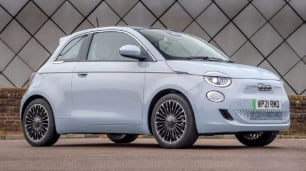The A 250 e is as interesting behind the wheel as it is on paper. To really explore it though, you'll need to delve into its complex drive modes.
It's more than just your usual comfort, eco, and sport. Each mode transforms the way you'll think about and drive this car.
The default is comfort, where the A 250 e behaves like you might expect from a plug-in. This means it will prefer to use electric drive unless you push the accelerator very hard. It makes for smooth and quiet motoring, although you'll find it chews through the electric range quite quickly, especially if you venture to the open road.
Sport mode prefers instead to primarily rely on the 1.3-litre four-cylinder engine. It's notably less refined, with this engine having a loud, gruff tone, and the introduction of vibrations and jerkiness from the dual-clutch automatic becomes immediately apparent.
It also firms up the steering, changes the transmission characteristics, and offers faster engine response from the accelerator pedal. As a side note, sport mode becomes a good tool for charging the battery quickly when you don't have access to a charging port.
The more interesting modes are electric, eco, and battery level. Battery level attempts to maintain the level the battery is currently at, while still using the car's hybrid features. This is so you can save the lion's share of charge for when it's most useful, like trawling in traffic.
Electric does what it says on the tin. Operates the car as an EV, not using its combustion engine at all. It also changes the car's paddle shifters from operating the transmission to altering the regenerative braking.
It offers modes varying from D+ which uses electric drive but coasts like a combustion car, to D-- which makes the car drive like a ‘single pedal' vehicle. This means it ups the regen braking to the point where the car will come to a full stop as you let your foot off the accelerator. It's the most efficient electric motoring mode.
Finally, eco mode lets you drive the A 250 e more like a conventional hybrid, limiting the electric motor to just taking off and cruising, preferring to switch to combustion more rapidly on acceleration.
While this car offers you unparalleled choice when it comes to electric motoring, it's worth noting it comes with its fair share of compromise.
This is far from the most refined car to drive in combustion mode, and it lacks the polish of, say, a Toyota hybrid when operating as a more traditional hybrid car.
I find it particularly interesting this car's best traits are found when it's operating as a purely electric vehicle. It's quieter, more refined, and the overpowered electric motor helps it feel just as good as a pure EV in terms of acceleration.
This car's downfalls as a combustion vehicle will be a real challenge for it. Again, it's a trade-off. The A 250 e doesn't feeel any heavier or more cumbersome than a 'normal' A-Class despite the extra battery size. But the ride is a bit harsh, and the dual-clutch leaves a lot to be desired in terms of refinement.
Asking more than $60 grand still seems tall when it's not as slick as a VW combustion car, and not as polished as a Toyota hybrid, either of which are half the price.

.png)